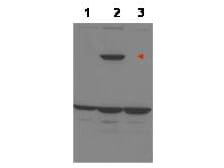Anti-ASPP1 (RABBIT) Antibody
ASPP1 Antibody
- SPECIFICATION
- CITATIONS
- PROTOCOLS
- BACKGROUND

| Host | Rabbit |
|---|---|
| Conjugate | Unconjugated |
| Target Species | Human |
| Reactivity | Human |
| Clonality | Polyclonal |
Application
| WB, E, I, LCI |
| Application Note | This affinity purified antibody has been tested for use in ELISA and western blotting. Specific conditions for reactivity should be optimized by the end user. Expect a band approximately 120 kDa in size corresponding to ASPP1 by western blotting in the appropriate cell lysate or extract. |
| Physical State | Liquid (sterile filtered) |
| Buffer | 0.02 M Potassium Phosphate, 0.15 M Sodium Chloride, pH 7.2 |
| Immunogen | This affinity purified antibody was prepared from whole rabbit serum produced by repeated immunizations with a synthetic peptide corresponding to an internal sequence of human ASPP1. |
| Preservative | 0.01% (w/v) Sodium Azide |
| Gene ID | 23368 |
|---|---|
| Other Names | 23368 |
| Purity | This affinity purified antibody is directed against human ASPP1. The product was affinity purified from monospecific antiserum by immunoaffinity chromatography. Minimal reactivity occurs against ASPP2. A BLAST analysis was used to suggest cross-reactivity with ASPP1 from mouse based on a 92% homology with the immunizing sequence. Reactivity against homologues from other sources is not known. |
| Storage Condition | Store vial at -20° C prior to opening. Aliquot contents and freeze at -20° C or below for extended storage. Avoid cycles of freezing and thawing. Centrifuge product if not completely clear after standing at room temperature. This product is stable for several weeks at 4° C as an undiluted liquid. Dilute only prior to immediate use. |
| Precautions Note | This product is for research use only and is not intended for therapeutic or diagnostic applications. |
| Name | PPP1R13B |
|---|---|
| Synonyms | ASPP1, KIAA0771 |
| Function | Regulator that plays a central role in regulation of apoptosis via its interaction with p53/TP53 (PubMed:11684014, PubMed:12524540). Regulates TP53 by enhancing the DNA binding and transactivation function of TP53 on the promoters of proapoptotic genes in vivo. |
| Cellular Location | Cytoplasm. Nucleus. Note=Predominantly cytoplasmic. Some fraction is nuclear |
| Tissue Location | Reduced expression in breast carcinomas expressing a wild-type TP53 protein. |

Thousands of laboratories across the world have published research that depended on the performance of antibodies from Abcepta to advance their research. Check out links to articles that cite our products in major peer-reviewed journals, organized by research category.
info@abcepta.com, and receive a free "I Love Antibodies" mug.
Provided below are standard protocols that you may find useful for product applications.
Background
ASPP (ankyrin-repeat-, SH3-domain- proline-rich-region protein) proteins (ASPP1, ASPP2 and iASPP) represent a new family of p53 binding proteins. ASPP1 and ASPP2 bind and enhance p53-mediated apoptosis. In contrast, iASPP functionally inactivates p53. ASPPs may also regulate p63- and p73-mediated apoptosis. Both ASPP1 and 2 directly interact with p53 and specifically enhance the apoptotic function of p53 by stimulating its DNA binding and transactivation function on promoters of pro-apoptotic genes, such as Bax and PIG-3. Not all cell cycle arrest genes are affected, such as p21. Interestingly, expression of ASPP is frequently down-regulated in human breast carcinomas expressing wild-type p53 but not mutant p53. Therefore, ASPP might regulate the tumor suppression function of p53 in vivo.
If you have used an Abcepta product and would like to share how it has performed, please click on the "Submit Review" button and provide the requested information. Our staff will examine and post your review and contact you if needed.
If you have any additional inquiries please email technical services at tech@abcepta.com.













 Foundational characteristics of cancer include proliferation, angiogenesis, migration, evasion of apoptosis, and cellular immortality. Find key markers for these cellular processes and antibodies to detect them.
Foundational characteristics of cancer include proliferation, angiogenesis, migration, evasion of apoptosis, and cellular immortality. Find key markers for these cellular processes and antibodies to detect them. The SUMOplot™ Analysis Program predicts and scores sumoylation sites in your protein. SUMOylation is a post-translational modification involved in various cellular processes, such as nuclear-cytosolic transport, transcriptional regulation, apoptosis, protein stability, response to stress, and progression through the cell cycle.
The SUMOplot™ Analysis Program predicts and scores sumoylation sites in your protein. SUMOylation is a post-translational modification involved in various cellular processes, such as nuclear-cytosolic transport, transcriptional regulation, apoptosis, protein stability, response to stress, and progression through the cell cycle. The Autophagy Receptor Motif Plotter predicts and scores autophagy receptor binding sites in your protein. Identifying proteins connected to this pathway is critical to understanding the role of autophagy in physiological as well as pathological processes such as development, differentiation, neurodegenerative diseases, stress, infection, and cancer.
The Autophagy Receptor Motif Plotter predicts and scores autophagy receptor binding sites in your protein. Identifying proteins connected to this pathway is critical to understanding the role of autophagy in physiological as well as pathological processes such as development, differentiation, neurodegenerative diseases, stress, infection, and cancer.


